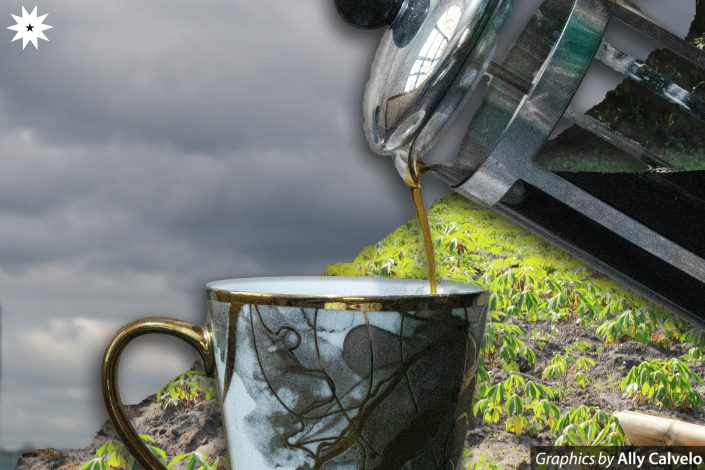
Coffee has become an integral part of numerous people’s daily routines all over the world. But there may come a time in the near future when this routine is disrupted.
While coffee is not set to disappear from the world forever, the effects of climate change on agriculture may indicate a future where coffee quality and affordability may begin to decline.
The ‘Goldilocks plant’
Coffee is a complicated crop to cultivate and requires precise temperature and soil quality to grow to its full potential. According to Aaron Davis, head of the coffee research unit at the Royal Botanic Gardens, even small changes in rainfall may have a dramatic effect on its yield and flavor profile. “Coffee’s a ‘Goldilocks’ plant. It can only grow under certain conditions,” he explains, referencing the particularity of the storybook character.
Davis describes Coffea arabica to be an especially sensitive crop. To produce the cherished beans, they are grown at high altitudes in regions where the average annual temperature hovers between 64 and 70 degrees Fahrenheit. Accounting for over 60 percent of the world’s coffee supply, it has historically been planted in the “Bean Belt”—an imaginary band stretching from Central America to sub-Saharan Africa and Southeast Asia.
As the climate in the belt continues to warm, some coffee farmers are forced to move up the mountains in search of cooler areas. Finding a new plot of land, however, is not easy. Most coffee trees take three to four years to mature and produce berries. It is also inherently limited; the amount of available land shrinks the closer it is to the mountain’s peak. Inevitably, farmers will run out of space for their crops—an issue that could exacerbate the already-disastrous practice of deforestation.
While Coffea canephora (robusta) is a significantly hardier plant than arabica, unpredictable weather patterns can cause its trees to flower too early or sporadically, resulting in uneven cherry maturation and prolonged harvest seasons. Additionally, natural disasters can prevent coffee from even making it to the market. Floods and landslides, for example, can destroy processing mills and disrupt shipping routes between the farms, mills, and ports.
Other threats include the coffee leaf rust, a type of fungus, and the coffee berry borer (CBB), a beetle whose plagues are driven in part by warmer and wetter weathers. The fungus infects the leaves of coffee trees, coating it with orange-colored dust—owing to the rust-like appearance—that makes it impossible for the tree to supply itself with nutrients. Meanwhile, the CBB bores into coffee cherries and plants their eggs inside the seeds.
Coffee’s carbon footprint
While the coffee industry is greatly affected by climate change, it also manages to contribute to it as well. With an estimated two billion cups of coffee consumed everyday, the high production of coffee is expected to have an effect on the environment.
This can particularly be attributed to the way in which coffee plants are grown. As the plants are small, short trees that require sunlight to grow, some coffee plantations create large fields that can house these crops. To make way for this, various trees are cut down, destroying the habitat for numerous insects and animals. The pesticides added to these plants also contribute to the amount of greenhouse gas emissions in the atmosphere.
The creation of one’s everyday cup of coffee also leaves a carbon footprint. This, however, creates a smaller impact compared to coffee production, whose degree of impact varies depending on the method used to create it. For instance, the drip filter method—a way of brewing coffee by pouring hot coffee ground into a filter—packs a larger impact because it requires the greatest amount of coffee and consumes plenty of electricity.
The use of coffee capsules—small, single-use pods that contain coffee grounds—may seem to be more environmentally harmful at first glance, since they use a lot of materials to create the capsules themselves. But, studies have shown that it is actually less harmful to the environment than the drip filter coffee. This is because the latter method uses more coffee grounds than coffee capsules, creating more residual waste.
Brewing a sustainable future
While many coffee researchers agree that crop production is facing a crisis, Davis argues that the focus on climate change is overshadowing the real dilemmas of coffee growing. He says that many are limiting themselves to breeding climate-resistant and flavorful coffee, but this requires scientists and farmers to keep up with the pace of climate change. “Even naturally heat-tolerant plants will perform poorly if heat waves become more severe,” he says.
A more sustainable model of production is agroforestry, which involves growing coffee alongside an array of species. This leads to increased biodiversity and creates a canopy-like environment that can protect the soil from erosion and changing weather conditions. But it still has a trade-off: lower yields. In such a volatile market, most coffee farmers have little to invest in taking proper care of their plants, let alone adopting eco-friendly practices.
Coffee is arguably one of the most important agricultural products despite not being a basic food crop. Valued as high as USD 126 billion in 2022 and grown in more than 70 countries, it is one of the most heavily traded commodities in terms of monetary value. Yet for all of its appeal, creating financial incentives for those with their hands in the dirt—and the most to lose—remains a challenge for governments and environmental organizations.
Ultimately, more support must be provided to coffee farmers and measures must also be implemented to mitigate the effects of climate change. Otherwise, people may not only grapple with the loss of a good hot drink but also the potential disasters in coffee farms, which could destroy livelihoods and be forerunners of other problems to come.
